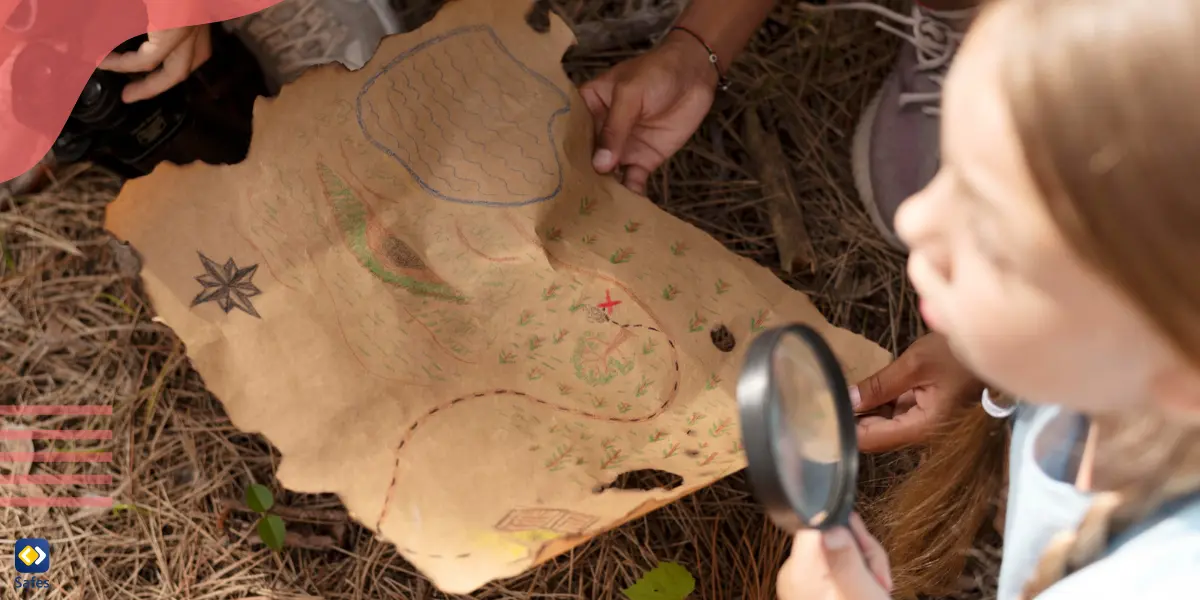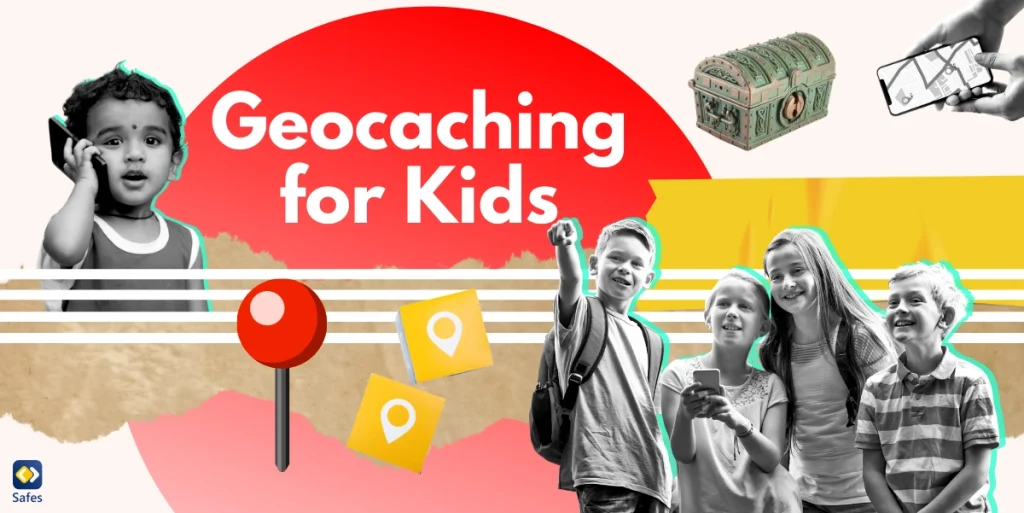Geocaching is an exciting outdoor adventure where participants use GPS devices or smartphones to find hidden containers, called “geocaches,” scattered all over the world. This modern-day treasure hunt is gaining popularity among families, offering a perfect blend of technology and nature. Kids, in particular, find geocaching fascinating as it turns a regular walk into a thrilling quest.
Download and Start Your Free Trial of the Safes Parental Control App
Outdoor activities are crucial for children’s development, providing both physical exercise and mental stimulation. Geocaching encourages kids to explore their surroundings, enhancing their observational skills and fostering a sense of adventure. It’s a unique way to break free from screen time and engage in the real world.
Parents, take note: geocaching isn’t just fun; it’s educational too. This activity promotes problem-solving, teamwork, and patience. It’s an excellent opportunity for children to learn about geography, nature, and the importance of persistence. Geocaching for kids is more than a game – it’s an educational journey disguised as play.
What Is Geocaching?
Geocaching is an interactive outdoor game where participants use GPS devices to locate hidden containers called caches. Think of it like a modern-day treasure hunt. Players follow GPS coordinates to find these caches, which can be hidden in parks, urban areas, or even remote locations. It’s an adventure that combines technology with exploration.
Caches come in various forms, known as cache types. The most common are traditional caches, which include a logbook and sometimes small trinkets. Multi-caches involve multiple stages, leading you to the final cache. Imagine the thrill of discovering hidden treasures like finding Pokémon in Pokemon Go, but in real life!
Geocaching began in May 2000, shortly after the U.S. government made GPS technology available for public use. Dave Ulmer hid the first cache in Oregon, marking the start of this global phenomenon. Since then, millions of caches have been hidden worldwide, evolving the activity into a beloved pastime.
Benefits of Geocaching for Kids
Geocaching is more than a treasure hunt; it’s a multifaceted adventure that benefits children’s physical, mental, and social well-being.
Physical Health
Outdoor geocaching for kids encourages them to get off the couch and explore the world around them. It’s a good way to ensure they engage in physical activity, whether hiking through a forest or strolling in a park. Such adventures improve their fitness levels and coordination, making geocaching a year-round activity—perfect for spring and winter activities for kids.
The Texas A&M GEAR study tracked 1,000 geocachers for 14 months using movement devices and logbooks to record their geocaching intensity. The research found that those who geocached weekly were more likely to meet national physical activity guidelines and report good or very good health.
Participants reported fewer poor health days and improved overall well-being. The study highlighted geocaching’s benefits for physical fitness, mental engagement, and outdoor exploration, emphasizing its potential as a health-promoting activity for children and adults alike.
Mental and Educational Benefits
Geocaching enhances problem-solving and critical thinking skills as children decipher clues and navigate to caches. It’s a fun, hands-on way to learn navigation and geography, bringing maps and coordinates to life. Moreover, geocaching provides a real-world application of STEM concepts, making learning both engaging and practical.
Social and Emotional Benefits
Geocaching is an excellent activity for promoting teamwork and family bonding. Working together to find caches strengthens communication and collaboration skills. As kids successfully locate caches, they build confidence and a sense of accomplishment, celebrating their achievements with high-fives and sharing joy with their families.

Getting Started With Geocaching
To start geocaching, you’ll need a few essential tools. A reliable GPS device or a smartphone with a geocaching app is crucial. Handheld GPS units are popular for their precision, while offline maps are handy when you’re out of signal range. Consider investing in a geocaching device for kids, designed to be user-friendly and durable. Ensure kids wear comfortable clothing and sturdy shoes to handle various terrains.
Using geocaching websites and apps is the best way to find geocaches. The best geocaching app is probably the official Geocaching app as it is highly recommended. It provides detailed maps and allows you to navigate directly to caches. This app helps you find geocaches by offering coordinates and hints. Understanding how to read these coordinates and interpret hints will greatly improve your success rate.
The app also features options to filter caches by difficulty and terrain ratings, ensuring you select age-appropriate adventures. Some of the geocaching apps also include features like offline maps, which are especially handy in areas with poor signal.
Finally, safety is very important when geocaching with kids. Always supervise children and ensure everyone stays together. Pay attention to difficulty and terrain ratings to choose appropriate caches. Be mindful of the environment and potential hazards, such as rough terrain or wildlife. Remember, geocaches can be hidden within 30 feet of the listed coordinates, so stay vigilant and enjoy the hunt responsibly.
Tips for a Successful Geocaching Adventure With Kids
By following the following tips, you can ensure a successful and enjoyable geocaching adventure with your kids, creating lasting memories and instilling valuable skills and principles.
Preparing for the Adventure
- Plan the Trip and Select Age-Appropriate Caches: Start geocaching by planning your trip and choosing caches suitable for your children’s ages. Look for easy caches to build confidence and excitement. Use geocaching websites or apps to navigate to the caches and ensure they are family friendly.
- Pack Snacks, Water, and Other Essentials: A well-prepared trip ensures a pleasant adventure. Pack plenty of snacks, water, sunscreen, and a first-aid kit. Comfortable clothing and sturdy footwear are also crucial for a fun and safe experience.
Engaging Kids During the Hunt
- Make the Search Fun With Games and Challenges: Turn the search into an exciting treasure hunt by incorporating games and challenges. Encourage kids to take turns leading the way and decoding clues, making the geocache to find a fun and educational adventure.
- Encourage Curiosity and Exploration: Foster a sense of adventure by encouraging curiosity about the environment. Discuss the nature, history, or science themes related to the cache locations. This can turn a simple treasure hunt into an engaging learning experience.
Teaching Responsibility and Respect
- Leave No Trace Principles: Teach kids the Leave No Trace principles to instill respect for nature. Encourage them to clean up any litter they find and to leave the environment as they found it.
- Respecting Nature and Other Geocachers: Emphasize the importance of respecting the work of other geocachers and the environment. Teach kids to sign the logbook, thank the cache owner, and leave the cache as they found it or better. This helps maintain the integrity of the geocaching community and the natural areas where caches are hidden.

Fun Geocaching Activities for Kids
Incorporating the following activities will make geocaching adventures more engaging and educational for kids, fostering a love for exploration and discovery.
Themed Geocache Hunts
Creating themed geocache hunts can greatly enhance the excitement for kids. Tailor the adventure to match their interests, such as a pirate treasure hunt, an animal safari, or a fairy-tale quest. Themed hunts not only make finding caches more engaging but also encourage kids to use their imagination and creativity.
Geocaching Challenges
Introduce geocaching challenges to add an extra layer of fun. Set goals for kids, like finding a certain number of caches in a day or locating creative geocaches with unique containers. These challenges can spark friendly competition and motivate kids to explore more actively.
Creative Cache Ideas
Encourage kids to craft and hide their own geocaches. They can design containers that blend with the environment, such as camouflaged boxes or disguised everyday items. This activity teaches them about the cache owner’s role and the importance of maintaining the geocaching community.
Using Safes for Geocaching Adventures
Our parental control app, Safes, can help parents manage and monitor their children’s time effectively, ensuring a balance between digital activities and outdoor adventures like geocaching.
Safes offers several features that are invaluable for parents. Activity tracking is particularly useful when children embark on solo geocaching adventures, allowing parents to keep an eye on their whereabouts. Time limits can be set to ensure kids don’t spend excessive time on screens, freeing up time for outdoor activities. Additionally, the app allows for monitoring social media use and setting boundaries with app management.
Safes is available for both iOS and Android. Safes also offers a free trial, making it easy to explore its features without commitment. If you’re looking for options more sophisticated than parental controls on Android, give safes a try!
Summing Up: Adventure Awaits With Geocaching
Geocaching offers numerous benefits for kids, from encouraging physical activity and enhancing problem-solving skills to fostering a love for nature and adventure. It’s a wonderful way for families to bond, learn, and have fun together outdoors. The excitement of finding caches and the educational aspects make it an ideal activity for children.
We encourage you to embark on this educational outdoor adventure as a family. Geocaching can turn any walk into a treasure hunt, providing endless opportunities for exploration and discovery. Start your geocaching adventure today and create lasting memories with your kids!
Your Child’s Online Safety Starts Here
Every parent today needs a solution to manage screen time and keep their child safe online.
Without the right tools, digital risks and excessive screen time can impact children's well-being. Safes helps parents set healthy boundaries, monitor activity, and protect kids from online dangers—all with an easy-to-use app.
Take control of your child’s digital world. Learn more about Safes or download the app to start your free trial today!




